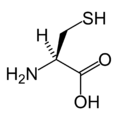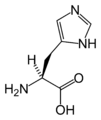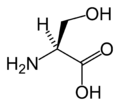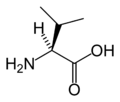
Disclaimer: I am not a nutritionist.
I tried to cover the importance of protein a while back. Here.
I only looked into this because I worry about my upcoming surgery.
In eukaryotes, there are only 21 proteinogenic amino acids, the 20 of the standard genetic code, plus selenocysteine.
In eukaryotes, there are only 21 proteinogenic amino acids, the 20 of the standard genetic code, plus selenocysteine.
Humans can synthesize 12 of these from each other or from other molecules of intermediary metabolism.
The other nine must be consumed (usually as their protein derivatives), and so they are called essential amino acids. The essential amino acids are histidine, isoleucine, leucine, lysine, methionine, phenylalanine, threonine, tryptophan, and valine.
Three are BCAAs: leucine, isoleucine, and valine
| Essential | Conditionally essential[3][4] | Non-essential |
|---|---|---|
| Histidine (H) | Arginine (R) | Alanine (A) |
| Isoleucine (I) | Cysteine (C) | Aspartic acid (D) |
| Leucine (L) | Glutamine (Q) | Asparagine (N) |
| Lysine (K) | Glycine (G) | Glutamic acid (E) |
| Methionine (M) | Proline (P) | Serine (S) |
| Phenylalanine (F) | Tyrosine (Y) | Selenocysteine (U) |
| Threonine (T) | Pyrrolysine* (O) | |
| Tryptophan (W) | ||
| Valine (V) |
The most abundant amino acids are: Cysteine, cystine, serine, glutamic acid, glycine, threonine, arginine, valine, leucine and isoleucine. Alpha keratin, fibrous and with a low sulphur content, is the protein we find in the greatest quantity in hair. It has a molecular weight of around 45,000 and is insoluble in water.
Some 18 amino acids can be found in the hair, such as proline, threonine, leucine and arginine. Keratin is particularly rich in cysteine (a type of sulfurated amino acid), which forms disulfide bonds between molecules, adding rigidity and resistance to the entire structure.
The 18 found in human hair are alanine, arginine, aspartic acid, cystine, glutamic acid, glycine, histidine, isoleucine, leucine, lysine, methionine, phenylalanine, prolyne, serine, threonine, tryptophan, tyrosine and valine. In the list of the18 amino acids, are all 9 essential amino acids as well.
In the anime, Akemi Soryuin has an average metabolic rate of 1366 calories burned per day. Otherwise her measurements are the same.
- Alanine is found in the highest concentrations in gelatin products, seaweed products, egg, turkey and beef.
- Arginine is found in the highest concentrations in more obscure food sources, but some of the higher concentrations are found in crab, shrimp, lobster and spinach.
- Aspartic acid is found in nectarines, peaches, cherries, plums, apricots, strawberries, lime and grapefruit.
- Cysteine is found in the highest concentrations in egg white, beef, pork, milk and halibut. The amino acid cysteine forms the disulfide bonds between the other molecules and adds rigid strength to the hair structure. The rigid strength to hair is something that seems to be underrated a lot, but it is what gives hair the ability to snap and break instead of being pulled until the structural integrity is ruined.
- Glutamic acid is found in the highest concentrations in soy protein products, defatted sunflower seed and peanut flour, egg white and parmesan.
- Glycine is found in gelatin products, pork skin, pork products in general, chicken breast, and lamb.
- Histidine is an essential amino acid. It's found in the highest concentrations in more obscure food sources, but some of the higher concentrations are found in parmesan, deer, defatted sunflower seed and peanut flour and pork
- Isoleucine is an essential amino acid. Isoleucine is found in egg white, seaweeds, turkey, chicken and lamb.
- Leucine is an essential amino acid. It's found in egg white, soy protein products, seaweed, chicken and tuna.
- Lysine is an essential amino acid. Lysine is found in chicken, pudding, honey, canned pears, margarine and corn starch.
- Methionine is an essential amino acid. It's found in egg white, halibut, chicken, tuna and turkey.
- Phenylalanine is an essential amino acid. Phenylalanine is found in pollock, grouper, tilapia, duck, chicken, turkey and shrimp.
- Prolyne is found in gelatin products, beef products, cream cheese, cottage cheese, savoy cabbage, cheddar and Colby cheese.
- Serine is found in egg white, soy protein products, seaweed, turkey, cottage cheese and cream cheese.
- Threonine is an essential amino acid. Threonine is found in watercress, seaweed, turkey and in fish like tilapia, tuna, pike and cod.
- Tryptophan is an essential amino acid. It's found in seaweed, spinach, egg white, crab, shrimp and halibut.
- Tyrosine is found in seaweed, soy protein products, egg white, cottage cheese, salmon and turkey. The amino acid tyrosine is also part of the complicated process of hair producing melanin. There are two types: Pheomelanin, present in light hair and eumelanin, which is present in dark hair.
- Valine is an essential amino acid. Valine is found in egg white, seaweed, watercress, seaweed, turkey, tuna and cod.
I always consider the protein to calorie ratio, so to speak how many calories a gram of protein will "cost" me. 1 gram of protein is 4 calories of energy to the body. But how many extra calories gets "carried" with the protein content?
As a rule of thumb, a 1:10 ratio is really good, and not so easy to obtain.
Just for fun, here is chapter 7 of Danberu nan kiro moteru? which is the only chapter of the manga where they talk about nutrition.
I like the manga and the anime, so I figured it would be some nice entertainment to break the text up a bit with. So I'd like to use this to make a point....
Akemi Soryuin has an average metabolic rate of 1366 calories burned per day. Her lunch comes to 378 calories total, so this lunch is 27% of her daily calorie requirement.
Lets calculate her protein intake for this meal...
- Brown rice. 269 calories. Cooked, long-grained brown rice comes to around 110 calories per 100 gram, so 244 gram of rice. That's around 6,3 gram of protein. The protein to calorie rate is around 42:1.
- Boiled broccoli. 15 calories. Broccoli is around 35 calories per 100 gram, so that is around 45 gram. 1,2 gram of protein and a protein to calories ratio of 12,5:1. Not bad!
- Salted bitter melon. 9 calories. I'm not entirely sure what kind of melon this is, but a guestimate after looking around for a bit, would put this down as 50 grams of whatever kind of melon this is. Turns out there are a few different bitter melons out there. Half a gram of protein, and a ratio of 18:1.
- Pan-fried egg whites. 40 calories. The egg whites we have (Comes in a bottle instead of the individual packs, which is so much easier to work with) are 47 calories and 9,7 gram of protein per 100 gram/ml. So this is 85 ml of egg whites and 8,2 grams of protein. The ratio is 4,8:1, which is really good. Also consider the fact that egg whites are really high as a source for the amino acids on almost all amino acids.
- Steamed chicken breast. 45 calories. I assume this is without skin or anything, so around 110 calories per 100 gram and a 40 gram portion. With 23 gram of proteins per 100 grams, this is 9,2 grams of protein. The ratio is 4,7:1, which exactly beats out the egg whites for best ratio.
This 378 calories bento lands at 25,4 grams of protein. The ratio is 14,8:1, which is pretty good actually.
I would have gotten rid of the rice entirely, since it comes to 71% of the total calories.
But maybe that's just me who doesn't really care for rice, bread, potatoes and pasta in general (Strangely, that's mr Igor's favorites. He could seriously eat pita bread with butter all day every day. Gag.) And the steamed chicken breast sounds like it would taste like cardboard and sadness.
If Akemi Soryuin's breakfast and dinner is around the same amount of calories as her lunch, there is not much "space" left for the two snacks she mentions. Especially not with the mentioned mackerel.
I would have liked a little focus on the protein here, but it seems like the know what they're talking about just from running the numbers earlier!





































No comments:
Post a Comment